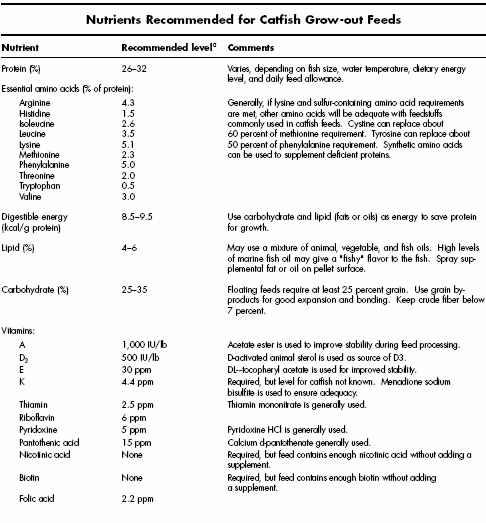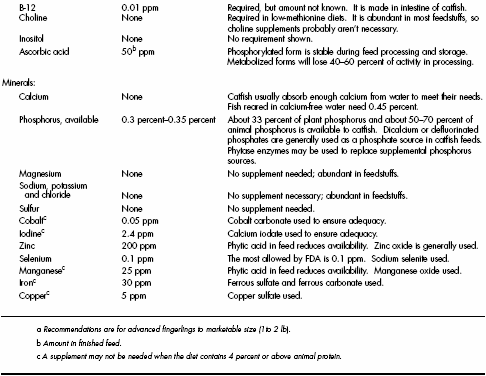Energy
Energy is one of the most important parts of the diet. Feeding standards for many animals are based on energy needs. Feed intake for catfish may be more a function of how much feed the catfish are allowed to have rather than energy concentration in the feed. Although catfish feed intake may not be strictly regulated by dietary energy, balance of dietary energy is important when formulating catfish feeds. This is true
mainly because a lack of nonprotein energy in the diet will result in the more expensive proteins being used for energy. Also, if dietary energy is too high, catfish may not eat as much, resulting in less intake of essential nutrients. Too high of a dietary energy/protein ratio may lead to higher body fat, which may reduce dressed yield and shorten shelf life of frozen products.
We dont know the absolute energy requirements for catfish. Estimates have been made by measuring weight gain or protein gain of catfish fed diets with a known amount of energy. Energy requirements reported for catfish, which have generally been expressed as a ratio of digestible energy (DE) to crude protein (DE/P), range from 7.4 to 12 kilocalorie/ gram (kcal/g). Based on current knowledge, a DE/P ratio of 8.5 to 9.5 kcal/g is adequate for use in commercial catfish feeds. Increasing the DE/P ratios of catfish diets above this range may increase fat deposition and reduce processed yield, and if the energy value is too low the fish will grow slowly. Carbohydrates and lipids (fats and oils) are the major energy sources for catfish.
Carbohydrates
Carbohydrates are the main form of energy stored in seeds, roots, and tubers. Carbohydrates have several functions in animals. But since animals can produce carbohydrates from lipid and protein, they do not need carbohydrates in the diet for normal growth and functions. Even though catfish do not need carbohydrates in their diet, catfish feeds contain considerable carbohydrates supplied from grain or grain byproducts (such as corn grain, wheat grain, and wheat middlings) that are rich in starch. Starch is not only an inexpensive energy source but also aids in feed manufacture. A typical catfish feed contains 25 percent or more soluble (digestible) carbohydrates plus 3 to 6 percent more carbohydrates that are generally present as crude fiber (mainly cellulose). Catfish cannot digest crude fiber well, so it should be kept at as low a level as possible. Commercial catfish feeds typically contain less than 5 percent crude fiber.
Lipids
Lipids (fats and oils) are an easily digested source of concentrated energy, having more than twice as much energy as an equal amount of carbohydrates. They play several important roles in an animals metabolism, including supplying essential fatty acids (EFA), helping absorb fat-soluble vitamins, and other important functions. Also, including lipids in the diet may increase food intake. Lipids stored in body tissues affect the flavor of the flesh. The type and amount of lipid in catfish diets is based on EFArequirements, economics, constraints of feed manufacture, and quality of fish flesh desired.
A small amount of lipid should be included to supply EFA. Catfish apparently require 0.5 percent to 0.75 percent omega-3 fatty acids in the diet. Aside from meeting EFArequirements, lipid is not necessarily required as a nutrient in the diet of catfish. But since it is a concentrated source of energy and is less expensive than protein, some fat should be included in catfish
diets. Too much dietary lipid, though, may result in too much fat deposited in the body. This may affect processed yield, product quality, and storage of processed products. Also, high-lipid feeds may be more difficult to pellet, but if needed, supplemental lipid can be sprayed onto the finished feed pellets.
Lipid levels in commercial feeds for food-sized catfish rarely exceed 5 to 6 percent. About 3 to 4 percent of the lipid is in the feed ingredients naturally, with the remaining 1 to 2 percent being sprayed onto the finished pellets. Spraying feed pellets with lipid increases
dietary energy and helps reduce feed dust ("fines"). Essential fatty acids can be supplied by marine fish oil such as menhaden oil. Natural food organisms, such as zooplankton, found in the pond are also a good source of EFA. High levels of fish oil may give "fishy" flavors to the catfish flesh. Catfish feeds manufactured in Mississippi are generally sprayed either with menhaden oil, catfish oil, vegetable oil, or a blend of oils.
Protein and Amino Acids
Protein comprises about 70 percent of the dry weight of fish muscle. Acontinual supply of protein is needed throughout life for maintenance and growth. Catfish, like other animals, need nitrogen and certain amino acids (see the chart below) rather than protein as such. Usually
the most economical source of these elements is a mixture of proteins in feedstuffs. Using protein for energy is expensive, so catfish feeds should be balanced to ensure adequate levels of nonspecific nitrogen, amino acids, and nonprotein energy are supplied in the right amounts.
The requirements for proteins and amino acids have been studied in catfish for many years, but there is still a debate as to which level of dietary protein is most cost effective. How much protein is needed for the most economical gain may differ as the cost of feed ingredients varies. Also, it is difficult to set a level of protein that is best for all situations because of the factors that affect the dietary protein requirement of catfish. These include water temperature, feed allowance, fish size, amount of nonprotein energy in the diet, protein quality, natural food available, and management practices.
For greatest profits the optimum dietary protein level should be changed as fish and feed prices change. But in practice, most catfish producers feed a diet with the same amount of protein throughout the growing season. Commercial catfish feeds used for growing food fish typically contain either 28 or 32 percent protein. Diets containing lower levels of protein are adequate for maximum growth but may increase body fat. Catfish fry and small fingerlings require diets with more protein. Fry diets used in the hatchery should contain 45 to 50 percent protein, and fingerlings (less than 20 lbs/1,000) should be fed a 35 percent protein diet.
Catfish feeds generally contain a mixture of plant and animal proteins, but amino acid requirements of catfish can be met with a mixture of plant proteins alone. Major protein sources used in catfish feeds include soybean meal, cottonseed meal, meat and bone/blood meal, and fish meal. Although meat and bone/blood meal is a good source of protein for catfish, we do not recommend using beef products in catfish feeds because of the possibility it may thought of as being related to mad cow disease.
Vitamins
Vitamins vary greatly in structure and function. They are generally defined as organic compounds animals require in small amounts in their diets for normal growth, health, and reproduction. Some vitamins may be made in the body and thus are not required in the diet. The amounts and quality of vitamins catfish need have been fairly well determined in lab and pond studies (see the chart below). Catfish feeds are generally supplemented with a vitamin premix that contains enough of all essential vitamins to meet the requirement and make up for losses from feed processing and storage. Vitamin losses during storage are not a major factor in the Mississippi Delta and other places where feed is generally not stored for more than 2 to 3 days.
Minerals
Apparently catfish need the same minerals for metabolism and bone development that other animals need. Catfish also require minerals for a balance between body fluids and their environment. They can absorb some of the minerals from the water. Fourteen minerals are considered to be essential to catfish.
Although mineral studies with fish are difficult to do, we know the mineral amounts they need, and we know the signs of mineral of deficiency.
Phosphorus is particularly important in fish feeds because fish require a fairly large amount of it. Feedstuffs, especially those from plants, are poor sources of phosphorus, and fish do not get enough phosphorus from pond water. As a result, catfish feeds are usually supplemented with phosphorus. Dicalcium and defluorinated phosphates are commonly used as phosphorus supplements in catfish feeds.
Catfish feeds are typically supplemented with a trace mineral premix with enough of all essential trace minerals (minerals required at very low levels) to meet or exceed dietary requirements of catfish (see the chart below). A trace mineral premix may not be needed in
catfish feeds that contain 4 percent or more animal protein.


Source: University of Missouri - March 2006


